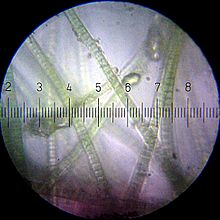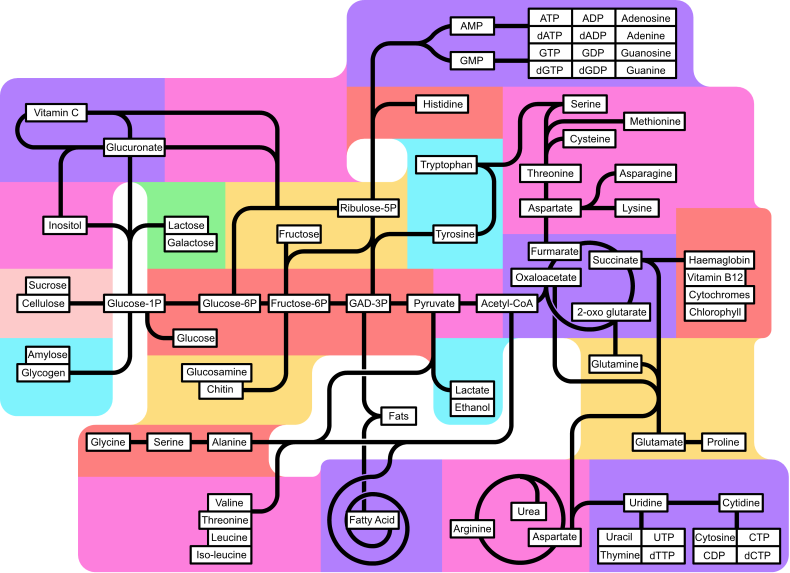Fiksacija ugljenika — разлика између измена
. |
(нема разлике)
|
Верзија на датум 16. април 2018. у 08:02
Један корисник управо ради на овом чланку. Молимо остале кориснике да му допусте да заврши са радом. Ако имате коментаре и питања у вези са чланком, користите страницу за разговор.
Хвала на стрпљењу. Када радови буду завршени, овај шаблон ће бити уклоњен. Напомене
|

Fiksacija ugljenika ili ugljenična asimilacija je proces konverzije neorganskog ugljenika (ugljen dioksida) do organskih jedinjenja posredstvom živih organizama. Najprominentniji primer je fotosinteza. Hemosinteza je još jedna forma ugljenične fiksacije, do koje može doći u odsustvu sunčevog svetla. Organizmi koji rastu putem fiksacije ugljenika se nazivaju autotrofima. Autotrofi obuhvataju fotoautotrofe, koji sintetišu organska jedinjenja koristeći energiju sunčevog svetla, and lithoautotrophs, which synthesize organic compounds using the energy of inorganic oxidation. Heterotrophs are organisms that grow using the carbon fixed by autotrophs. The organic compounds are used by heterotrophs to produce energy and to build body structures. "Fixed carbon", "reduced carbon", and "organic carbon" are equivalent terms for various organic compounds.[1]
Neto vs bruto CO2 fiksacija

It is estimated that approximately 258 billion tons of carbon dioxide are converted by photosynthesis annually. The majority of the fixation occurs in marine environments, especially areas of high nutrients. The gross amount of carbon dioxide fixed is much larger since approximately 40% is consumed by respiration following photosynthesis.[1] Given the scale of this process, it is understandable that RuBisCO is the most abundant protein on Earth.
Pregled puteva
Six autotrophic carbon fixation pathways are known as of 2011. The Calvin cycle fixes carbon in the chloroplasts of plants and algae, and in the cyanobacteria. It also fixes carbon in the anoxygenic photosynthetic in one type of proteobacteria called purple bacteria, and in some non-phototrophic proteobacteria.[2]
Kiseonična fotosinteza
In photosynthesis, energy from sunlight drives the carbon fixation pathway. Oxygenic photosynthesis is used by the primary producers—plants, algae, and cyanobacteria. They contain the pigment chlorophyll, and use the Calvin cycle to fix carbon autotrophically. The process works like this:
- 2H2O → 4e− + 4H+ + O2
- CO2 + 4e− + 4H+ → CH2O + H2O
In the first step, water is dissociated into electrons, protons, and free oxygen. This allows the use of water, one of the most abundant substances on Earth, as an electron donor—as a source of reducing power. The release of free oxygen is a side-effect of enormous consequence. The first step uses the energy of sunlight to oxidize water to O2, and, ultimately, to produce ATP
- ADP + Pi ⇌ ATP + H2O
and the reductant, NADPH
- NADP+ + 2e− + 2H+ ⇌ NADPH + H+
In the second step, called the Calvin cycle, the actual fixation of carbon dioxide is carried out. This process consumes ATP and NADPH. The Calvin cycle in plants accounts for the preponderance of carbon fixation on land. In algae and cyanobacteria, it accounts for the preponderance of carbon fixation in the oceans. The Calvin cycle converts carbon dioxide into sugar, as triose phosphate (TP), which is glyceraldehyde 3-phosphate (GAP) together with dihydroxyacetone phosphate (DHAP):
- 3 CO2 + 12 e− + 12 H+ + Pi → TP + 4 H2O
An alternative perspective accounts for NADPH (source of e−) and ATP:
- 3 CO2 + 6 NADPH + 6 H+ + 9 ATP + 5 H2O → TP + 6 NADP+ + 9 ADP + 8 Pi
The formula for inorganic phosphate (Pi) is HOPO32− + 2H+. Formulas for triose and TP are C2H3O2-CH2OH and C2H3O2-CH2OPO32− + 2H+
Reference
- ^ а б Geider, R. J., et al., "Primary productivity of planet earth: biological determinants and physical constraints in terrestrial and aquatic habitats", Global Change Biol. 2001, 7, 849–882. doi:10.1046/j.1365-2486.2001.00448.x
- ^ Swan BK, Martinez-Garcia M, Preston CM, Sczyrba A, Woyke T, Lamy D, Reinthaler T, Poulton NJ, Masland ED, Gomez ML, Sieracki ME, DeLong EF, Herndl GJ, Stepanauskas R (2011). „Potential for chemolithoautotrophy among ubiquitous bacteria lineages in the dark ocean”. Science. 333 (6047): 1296—300. Bibcode:2011Sci...333.1296S. PMID 21885783. doi:10.1126/science.1203690.
Literatura
- Berg IA (2011). „Ecological aspects of the distribution of different autotrophic CO2 fixation pathways”. Appl. Environ. Microbiol. 77 (6): 1925—36. PMC 3067309
 . PMID 21216907. doi:10.1128/AEM.02473-10.
. PMID 21216907. doi:10.1128/AEM.02473-10. - Keeling PJ (2004). „Diversity and evolutionary history of plastids and their hosts”. Am. J. Bot. 91 (10): 1481—93. PMID 21652304. doi:10.3732/ajb.91.10.1481.
- Keeling PJ (2009). „Chromalveolates and the evolution of plastids by secondary endosymbiosis”. J. Eukaryot. Microbiol. 56 (1): 1—8. PMID 19335769. doi:10.1111/j.1550-7408.2008.00371.x.
- Keeling PJ (2010). „The endosymbiotic origin, diversification and fate of plastids”. Philos. Trans. R. Soc. Lond. B Biol. Sci. 365 (1541): 729—48. PMC 2817223
 . PMID 20124341. doi:10.1098/rstb.2009.0103.
. PMID 20124341. doi:10.1098/rstb.2009.0103. - Timme RE, Bachvaroff TR, Delwiche CF (2012). „Broad phylogenomic sampling and the sister lineage of land plants”. PLoS ONE. 7 (1): e29696. Bibcode:2012PLoSO...7E9696T. PMC 3258253
 . PMID 22253761. doi:10.1371/journal.pone.0029696.
. PMID 22253761. doi:10.1371/journal.pone.0029696. - Spiegel FW (2012). „Evolution. Contemplating the first Plantae”. Science. 335 (6070): 809—10. Bibcode:2012Sci...335..809S. PMID 22344435. doi:10.1126/science.1218515.
- Price DC, Chan CX, Yoon HS, Yang EC, Qiu H, Weber AP, Schwacke R, Gross J, Blouin NA, Lane C, Reyes-Prieto A, Durnford DG, Neilson JA, Lang BF, Burger G, Steiner JM, Löffelhardt W, Meuser JE, Posewitz MC, Ball S, Arias MC, Henrissat B, Coutinho PM, Rensing SA, Symeonidi A, Doddapaneni H, Green BR, Rajah VD, Boore J, Bhattacharya D (2012). „Cyanophora paradoxa genome elucidates origin of photosynthesis in algae and plants” (PDF). Science. 335 (6070): 843—7. Bibcode:2012Sci...335..843P. PMID 22344442. doi:10.1126/science.1213561. Приступљено 10. 4. 2012.

